Cooling Your Home with Fans and Ventilation
March 5, 2017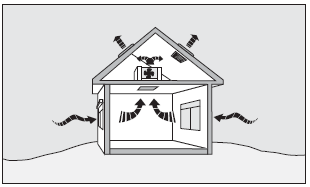
You can save energy and money when you ventilate your home instead of using
your air conditioner, except on the hottest days. Moving air can remove heat from your home. Moving air also creates a wind chill effect that cools your body.
Ventilation cooling is usually combined with energy conservation measures like
shading provided by trees and window treatments, roof reflectivity (light-colored
roof), and attic insulation. Mechanical air circulation can be used with natural ventilation to increase comfort, or with air conditioning for energy savings.
Ventilation provides other benefits besides cooling. Indoor air pollutants tend to accumulate in homes with poor ventilation, and when homes are closed up for air conditioning or heating.
Principles of Cooling
Cooling the Human Body your body can cool down through three processes: convection, radiation, and perspiration. Ventilation enhances all these processes. Convection occurs when heat is carried away from your body via moving air. If the surrounding air is cooler than your skin, the air will absorb your heat and rise. As the warmed air rises around you, cooler air moves in to take its place and absorb more of your warmth. The faster this convicting air moves, the cooler you feel. Radiation occurs when heat radiates across the space between you and the objects in your home. If objects are warmer than you are,
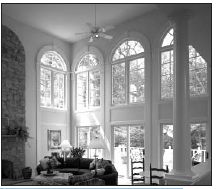
heat will travel toward you. Removing heat through ventilation reduces the temperature of the ceiling, walls, and furnishings. The cooler your surroundings, the less heat you’ll attract, and the more of your own excess heat you’ll lose. Perspiration can be uncomfortable, and many people would prefer to stay cool without it. However, during hot weather and physical exercise, perspiration is the body’s powerful cooling mechanism. Ceiling fans distribute cool air, making cooling equipment more efficient. Through all the living areas of your home. This may involve leaving some windows closed if they interfere with air moving along a longer path through the home.
Attic Ventilation
Solar heat travels in through the roof and radiates into the attic. Attic ventilation reduces attic temperature 10 to 25 degrees and slows the transfer of heat into the living space. However, the most effective way to reduce attic heat is to prevent it from entering in the first place with a reflective roof. Also very important is having at least a foot of attic insulation.
Mechanical Ventilation
When you know how air moves naturally through your home, you can then optimize your mechanical
ventilation. In warmer climates, natural ventilation can’t circulate enough air through a home to provide sufficient cooling at night to remove the day’s heat. Mechanical ventilation can provide continuously moving air that will keep your home cooler, day and night, with circulating fans, whole-house fans, and/or evaporative coolers. The quality and energy efficiency of these devices varies widely. Shop carefully—it might be best to buy from a dealer who specializes in fans rather than from a department store.
Circulating Fans
Circulating fans include ceiling fans, table fans, floor fans, window fans, and fans mounted to poles or walls. These fans create a wind chill effect that will make you more comfortable in your home, even if it’s also cooled by natural ventilation or air conditioning.
Ceiling Fans
If you use air conditioning, a ceiling fan will allow you to raise the thermostat setting about 4°F with no reduction in comfort. In temperate climates, or during moderately hot weather, ceiling fans may allow you to avoid using your air conditioner altogether. Install a fan in each room that needs to be cooled during hot weather. Fans work best when the blades are 7 to 9 feet above the floor and 10 to 12 inches below the ceiling. Fans should be installed so their blades are no closer than 8 inches from the ceiling and 18 inches from the walls. Larger ceiling fans can move more air than smaller fans. A36- or 44-inch-diameter fan will cool rooms up to 225 square feet, while fans that are 52 inches or more should be used in larger rooms. Multiple fans work best in rooms longer than 18 feet. Small- and medium-sized fans will provide efficient cooling in a 4- to 6-foot diameter area, while larger fans are effective up to 10 feet. A larger blade will also provide comparable cooling at a lower velocity than a smaller blade. This may be important in areas where loose papers or other objects will be disturbed by a strong breeze. The fan should also be fitted to the aesthetics of the room—a large fan may appear over-powering in a small room. A more expensive fan that operates quietly and smoothly will probably offer more trouble-free service than cheaper units. Check the noise ratings, and, if possible, listen to your fan in operation before you buy it.
Table fans provide refreshing breezes.
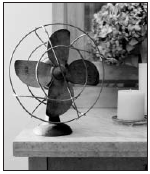
Whole-House Fans
A whole-house fan can substitute for an air conditioner most of the year in most climates. Whole-house fans combined with ceiling fans and portable fans provide acceptable summer comfort for many families, even in hot weather.
How Whole-House Fans Work
The whole-house fan pulls air in from open windows and exhausts it through the attic and roof. It provides good attic ventilation in addition to whole-house ventilation. You can regulate cooling by simply closing windows in the unoccupied areas and opening windows wide in occupied areas. Many people cool the bed-rooms at night and the living areas during the daytime.
Window and Exhaust Fans
Window fans are best used in windows facing the prevailing wind or away from it to provide cross ventilation. Window fan augment any breeze or create a breeze when the air is still. If the wind direction changes frequently in your area, use reversible-type window fans so you can either pull air into the home or push air out, depending on which way the wind blows. Experiment with positioning the fans in different windows to see which arrangement gives the best cooling effect. In a larger house, consider installing a window fan that blows air in through a lower-level window in a cool area and another window fan that blows air out through a higher-level window in a hotter area. Use exhaust fans in the kitchen and bath to remove heat and humidity when cooking and bathing. Larger, securely installed exhaust fans can ventilate homes where an open window would be a security issue. Large exhaust fans can be mounted out- doors on a wall or roof to reduce indoor noise. Be cautious with these large exhaust fans. If enough ventilation isn’t provided, the fans can pull combustion products (e.g. ,carbon monoxide from furnaces or water heaters) into your living space. Whole-house fans should provide houses with 30 to 60 air changes per hour (varies with climate, floor plan, etc.—check with a professional to determine what is appropriate for your home). The air-change rate you choose depends on your climate and how much you depend on the whole house fan for cooling. Cooler, shadier areas don’t require as much ventilation as warmer, sunnier ones. Houses entirely dependent on whole-house fans require a bigger fan because there is no air conditioning to fall back on.
Sizing a Whole-House Fan
Whole-house fans are sized in cubic feet per minute (cfm) of ventilating power. To determine the size you’ll need, first calculate the volume of your house in cubic feet. To do that, multiply the square footage of the floor area you want to cool by the height from floor to ceiling. Take that volume and multiply by 30 to 60 air changes per hour (depending on the power you need). Then, divide by 60 minutes to get the cubic feet per minute of capacity your house requires. [(Squarefeet______ x room height______) x 30 or 60
/ 60 = cfm required _________. ]

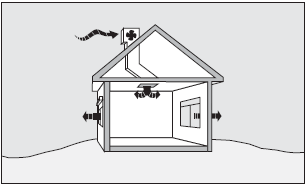
Installing and Using a Whole-House Fan
Installing a whole-house fan is tricky and should be done by a professional. Attic measurements, dedicated circuit wiring, and possibly new attic vent installation should be performed by an experienced person. Attic ventilation must be increased to exhaust the fan’s air outdoors. You’ll need 2 to 4 times the normal area of attic vents, or about one square foot of net free area for every 750 cfm of fan capacity. The net free area of a vent takes into account the resistance offered by its louvers and insect screens. More vent area is better for optimal whole-house fan performance. Some fans come with a tight-sealing winter cover (or you can build one). If you switch between air conditioning and cooling with a whole-house fan as the summer weather changes, build a tightly sealed, hinged door for the fan opening that is easy to open and close when switching cooling methods.
Drawbacks of Whole-House Fans
Whole-house fans can be noisy, especially if improperly installed. In general, a large-capacity fan running at low speed make less noise than a small fan operating at high speed. All whole-house fans should be installed with rubber or felt gaskets to dampen noise. You can set a multispeed fan to a lower speed when noise is a problem.
Evaporative Coolers
Evaporative coolers or swamp coolers are a popular and energy-efficient cooling strategy in dry climates of the United States. Hot outside air enters the swamp cooler. The air passes over water-saturated pads, and the water evaporates into the air. The energy used removes heat from the air. The 15- to 40-degree-cooler air is then directed into the home, and pushes warmer air out through windows. Because this process also humidifies the air, swamp coolers are best used in areas with low summertime relative humidity. Evaporative coolers use less than one third the energy of air conditioners, and cost about half as much to install. Unlike central air conditioning systems that recirculate the same air, evaporative coolers provide a steady stream of fresh air into the house.
Sizing and Selection
Evaporative coolers are rated by the cfm of air that they deliver to the house. Most models range from 3,000 to 25,000 cfm. Manufacturers recommend providing enough air-moving capacity for 20 to 40 air
changes per hour, depending on climate.
Installation
Evaporative coolers are installed in one of two ways: the cooler blows air into a central location, or the cooler connects to ductwork, which distributes the air to different rooms. Central-location installations work well for compact houses that are open from room to room. Ducted systems are required for larger houses with hall-ways and multiple bedrooms. Most people install down-flow evaporative
coolers on the roofs of their houses. However, many experts prefer to install ground-mounted horizontal units, which feature easier maintenance and less risk of roof leaks. Small horizontal-flow coolers are installed in windows to cool a room or section of a home. These portable evaporative coolers work well in moderate climates, but may not be able to cool a room adequately in hot climates. Room evaporative coolers are becoming more popular in areas of the western United States with milder summer weather. They can reduce the temperature in a single room by 5 to 15 degrees.
Operation
An evaporative cooler should have at least two speeds and a vent-only option. During vent-only operation, the water pump does not operate and the outdoor air is not humidified. This lets you use the evaporative cooler as a whole-house fan during mild weather. Control the cooler’s air movement through the house by adjusting window openings. Open the windows or vents on the leeward side of the house to provide 1 to 2 square feet of opening for each 1,000 cfm of cooling capacity. Experiment to find the right windows to open and the correct amount to open them. If the windows are open too far, hot air will enter. If the windows are not open far enough, humidity will build up in the home. You can regulate both temperature and humidity
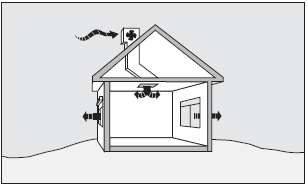
by opening windows in the areas you want to cool, and closing windows in unoccupied areas. Where open windows create a security issue, install up-ducts in the ceiling. Up ducts open to exhaust warm air as cooler
air comes in from the evaporative cooler. Evaporative coolers installed with up ducts will need additional attic ventilation. Filters remove most of the dust from incoming air—an attractive option for homeowners concerned about allergies. Filters can also reduce the tendency of some coolers to pull water droplets from
the pads into the blades of the fan. Most evaporative coolers do not have air filters as original equipment, but they can be fitted to the cooler during or after installation.
Evaporative Cooler Maintenance
Save yourself a lot of work and money by draining and cleaning your evaporative cooler regularly. Build-up of sediment and minerals should be regularly removed. Coolers need a major cleaning every season, and may need routine maintenance several times during the cooling season. The more a cooler runs, the more maintenance it will need. In hot climates where the cooler operates much of the time, look at the pads, filters, reservoir, and pump at least once a month. Replace the pads at least twice during the cooling season, or as often as once a month during continuous operation. Some paper and synthetic cooler pads can be cleaned with soap and water or a weak acid according to manufacturer’s instructions. Filters should be cleaned when the pads are changed or cleaned. Caution: Be sure to disconnect the electricity to the unit before servicing it.
Two-Stage Evaporative coolers
Two-stage evaporative coolers are newer and even more efficient. They use a pre-cooler, more effective pads, and more efficient motors. They don’t add as much humidity to the home as single-stage evaporative coolers, but are still much more efficient than air conditioners.
Drawbacks of Evaporative Coolers
Evaporative coolers should not be used in humid climates because they add humidity. Also, they cool your house down to a higher temperature than an air conditioner. They require maintenance (albeit easy) about once a month. If the cooler is installed on the roof, there is some roof deterioration caused by routine maintenance trips. As unlit rooftop cooler will be about 1 degree Fahrenheit less effective than a shaded cooler. Rooftop maintenance also requires using a ladder, which may be an inconvenience.
Managing Your
Home’s Ventilation
Remember the following if you plan to cool your home with ventilation:
- Learn how air flows naturally through your home.
- Take advantage of cool night air, and ventilate your home by natural or mechanical methods.
- Keep a clear path for airflow both inside and outside your windows.
- Close windows, doors, and window coverings in the morning before your home starts to heat up.
- Avoid producing heat in your home when it’s hot outside.
- Wear cool clothing.
- Raise your air-conditioning thermostat to a more economical temperature. Turn it off completely if you’ll be gone for an extended period.
